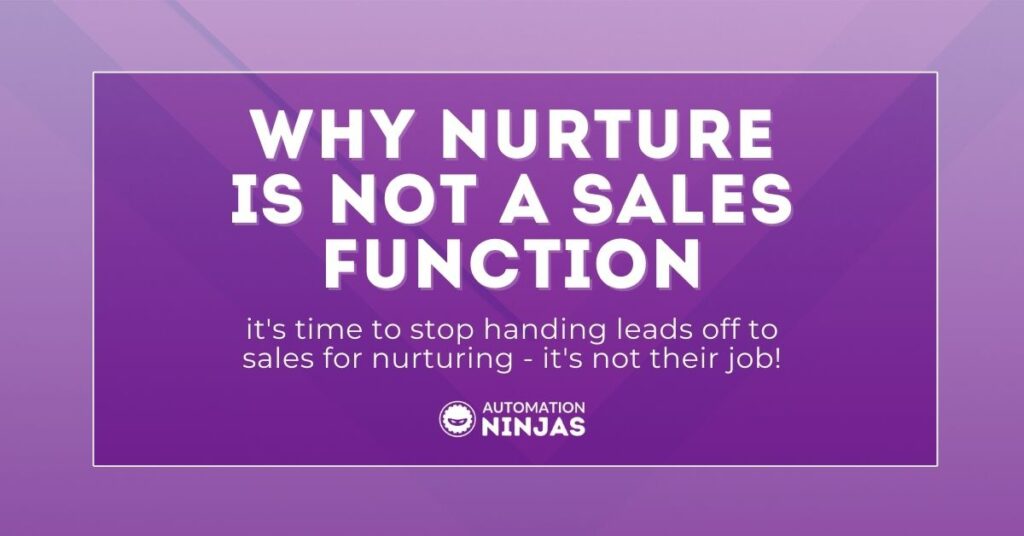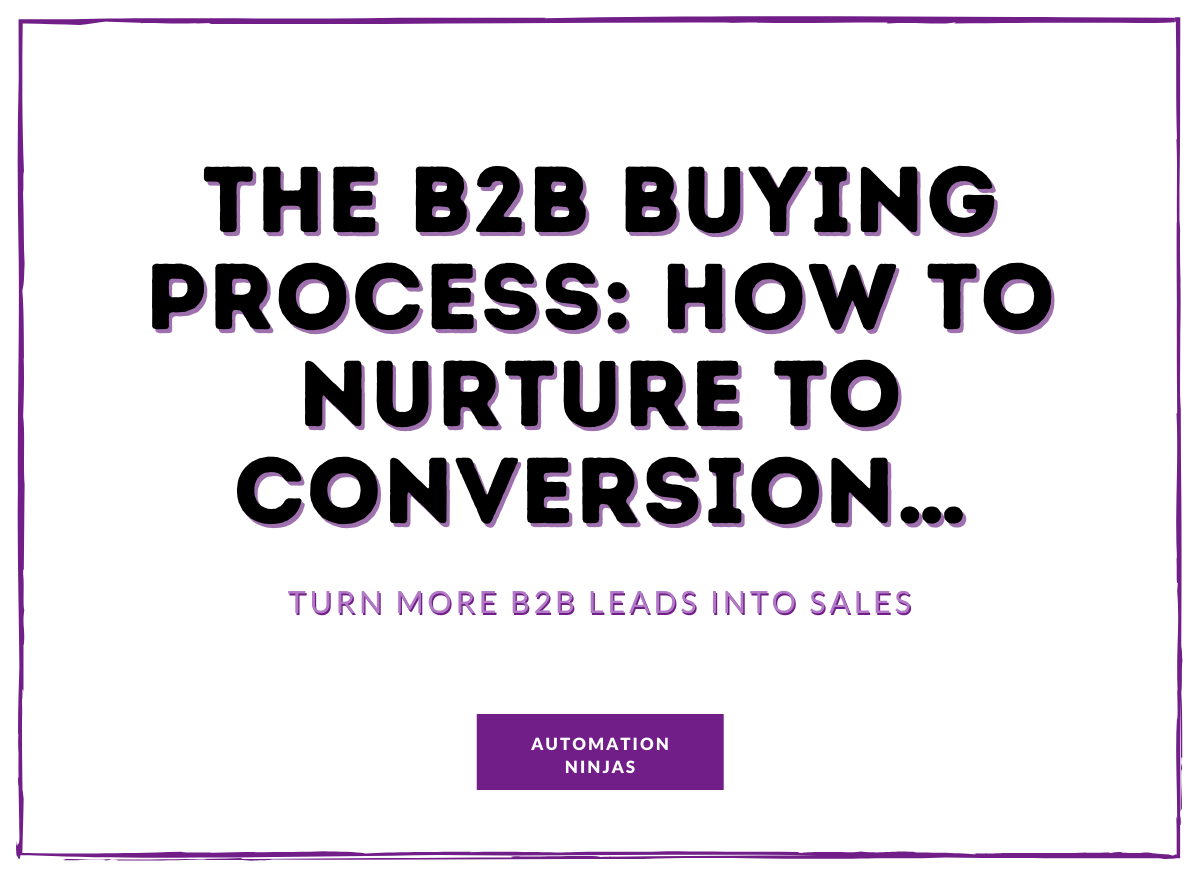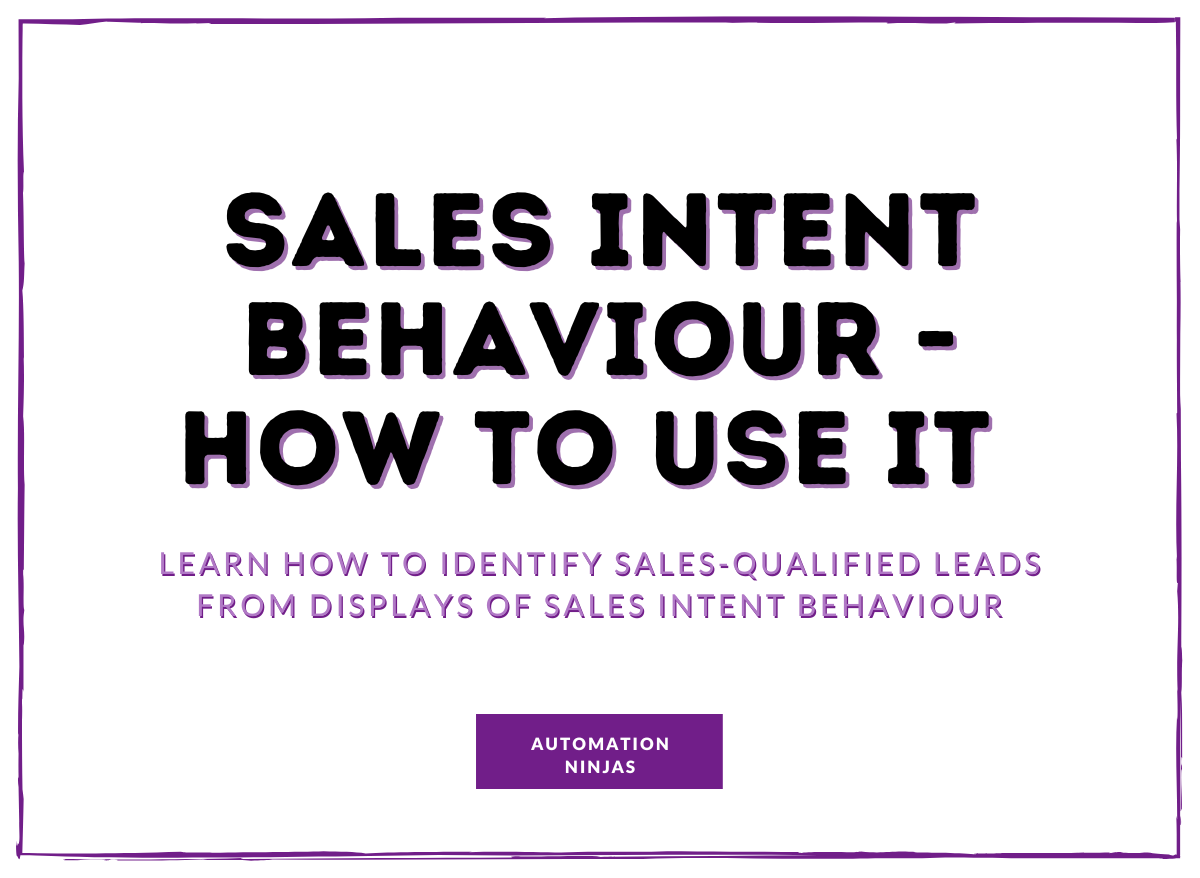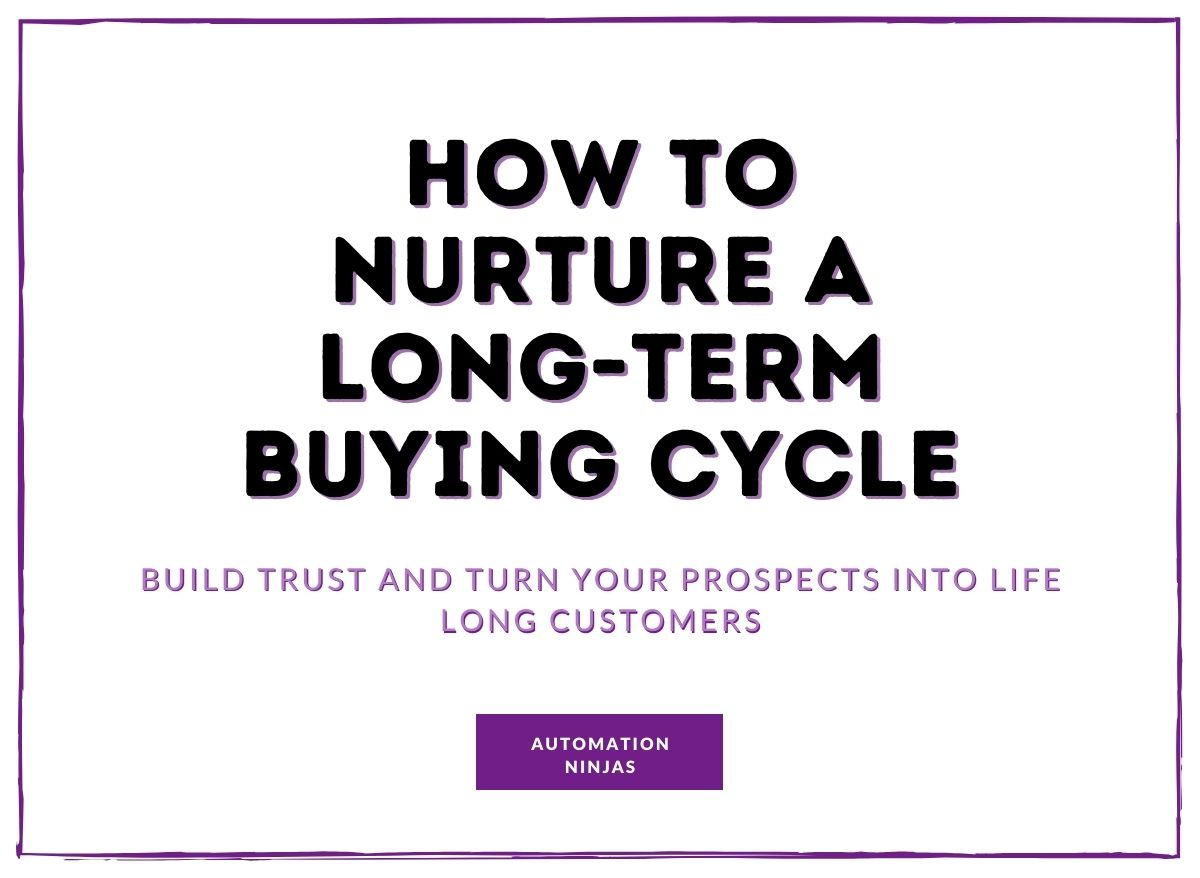AUTHOR: Kenda Macdonald
As a dedicated consultant, I specialise in elevating businesses through top-tier consultancy, fueled by a deep understanding of buyer psychology cultivated over years of experience. My expertise lies in crafting marketing and sales strategies that propel businesses to new heights by leveraging insights into the buyer brain. As a bestselling author, public speaker, and strategist, my passion for decoding human behavior drives me to innovate and deliver unparalleled results. I've designed a methodology adaptable for all types of businesses, ensuring transformative customer journeys and experiences.
Controversial statement time. I’m never one for shyness or pulling punches; if you know me, this won’t come as a surprise! The statement I’m about to make often gets people riled up. Are you ready?
Nurture is not a sales function.
I heard that gasp! Now, bear with me. It is not sales' job to nurture. It’s marketing’s job. Don’t hate me, marketing peeps; hear me out.
The function of sales as a definition is:
To focus on sales generation, customer acquisition and retainment, and business growth.
Sales’ job is to sell.
It’s to help the conversion complete. To help people make the right decisions about the products and services that you have to offer. They’re there to answer questions and get the deal across the line.
Nurture is a marketing function, and I’ll explain why…
When a lead becomes SQL (sales-qualified) that isn’t marketing’s opportunity to dust their hands off and be done with that lead. There is still much work to be done! (More on that in a minute.)
Nurture is crucial. And, it’s often the very first thing a sales team will drop when things get busy. And rightly so - they should focus on closing all the fantastic opportunities the marketing team has nurtured and handed them.
Here are a few stats to bring this home:
The real problem is that follow up and nurturing leads are fundamental to conversion:
80% of sales require five follow-up calls. (Invesp), and 81% of sales happen after seven or more interactions.
We also know that good nurture is fundamental to higher conversion rates, increased average order value, and happier customers.
>> Related Content: How To Do Lead Nurturing Successfully; Real Life Example <<
So, if Sales is going to drop this when they’re busy - or might not even do it in the first place - why would we leave this critical job to them?
We wouldn’t. That’s why it falls within the realm of the marketing team.
Your sales team should be busy. They should be working only with the most qualified of leads.
And yet just 33% of the internal sales-rep time is spent actively selling. (CSO Insights).
Fearing death by stats yet?

That’s just looking at it from an internal perspective. Casting a wary eye on it externally from the customer's perspective is also fun!
Let’s look at it from a customer’s point of view…
Customers don’t give a damn about your silos.
They don’t care if it’s marketing, sales, or fulfilment they’re dealing with. They just want a seamless experience.
What is your experience like? Do they have beautifully crafted marketing materials and gorgeous emails nurturing them right up until they show interest before being dumped into a manual process in which they either get hounded or ghosted by a sales rep? And when they do buy, a clunky fulfilment process?
What’s that journey really like for them?
The above journey might be an exaggeration, but at best, if you have a siloed process, your customer will feel the difference. We don’t want that; we want it to be smooth and frictionless for them.
So to save a little bit of time, increase our conversion rates and have happier customers - we should ensure that when a lead becomes SQL, we have nurture running alongside Sales’ efforts.
When Do Sales & Nurture Collide?
Ever heard of Sales Enablement? It is the act of creating excellent pieces of content and the processes to use them to enable sales to do what they do best. And the results from these initiatives can be staggering:
76% of companies report an increase in sales between 6%-20% after implementing sales enablement initiatives.
Usually, this sees marketing creating awesome buyer’s guides, pdfs, and videos to help sales. I’ve seen gorgeous spreadsheets, entire file sharing systems with sexy subfolders, and to-die-for naming conventions - all never used by sales.
YES! I hear you marketing folk say, “Sales hates our content! They don’t use the stuff we give them!”.
It’s usually that or, “Sales doesn’t like it when we get involved.” 🙁
Some teams can be very ‘no touchy my leads’ on the sales front. And I get that. They want to control their processes and have their way of doing things.
I present the same counterargument for both issues:
Marketing approaches sales enablement creation incorrectly.
Sales nurture is not a passive process. It’s not something that only gets utilised when it is remembered. It’s an active process that should be underpinning the whole sales journey. If you need a little statistical validation, here you go!
Only 25% of leads are ready to advance to later stages of the buying process.
But, we mustn’t just give up on and cast away the remaining 75%. They just need a little more loving (especially important for businesses with long sales cycles).
We want to do two things with our sales enablement:
- 1Help sales nurture
- 2Increase conversion rates and reduce conversion time.
Here is where Sales Motivation comes to the rescue.
Sales Enablement Content: The Sales Motivational Series
To truly enable sales and nurture the socks off your leads, you need to key into what they will need content-wise at those bottom-of-funnel buying stages.
First, identify where your sales team needs to get involved. What awareness stage does a lead become SQL vs. needing to speak to a human?
1 - Solution Aware
Here, leads want to understand the solutions available to them. What will solve their problem best?
They’re not looking for specific product information - they want to know whether options A, B or C will do the job. For example, they might need content creation. But do they need an in-house copywriter? Do they need an agency? Or do they need a Freelancer?
Usually, at this stage, Sales doesn’t need to get directly involved. Marketing can create content that helps leads figure this out for themselves. However, if the problem is complex - sometimes leads will need bespoke help to figure this out. Where do you sit?
2 - Product Aware
Here, leads have sussed out which solution works best for them. Now they want to find a particular product or service that will do the job within that solution. At this stage, leads often have product-specific questions and want to determine how to choose the best product.
Product Aware is the perfect stage for a helpful sales team to be involved. They can help leads make the best choice - and the content the marketing team creates can run comfortably alongside that process. Validating concerns and answering questions, prompting outreach and engagement.
3 - Most Aware
At this point, your lead is clear on the solution and the right product, and now they’re vetting you. Can you deliver your promise? What is your competition like? Can you back up your performance? What are your reviews like?
Most Aware is where your leads will have objections, questions about fulfilment, niggles, and concerns. It is where your case studies, testimonials, and all the detail on how you are different from your competitors are fundamental.
>> Related Content: The Clever Content Awareness Scale <<
Sales & Marketing Working Together <3
Throughout all these stages, the easiest way to help sales is to find out what questions they deal with consistently and what objections they must overcome. That content is invaluable to leads - and will help sales be more efficient.
One of my favourite moments of implementing a sales motivational series is watching a reluctant sales team get excited when their job gets easier, and their conversion rates go up.
Sitting down with your team and getting to know what holds up conversions is a fantastic way to break down barriers between silos and keep the journey seamless for your leads.
Help Sales be heroes, and they will help your customers be heroes.
Crucially, we should automate sales motivational content.
Remember, Sales get busy, and this will get dropped. Instead, when someone hits the right stages, get your marketing automation to send out a series of emails (your Sales Motivational Series) that delivers this nurturing bottom-of-funnel content. It’s well worth the effort:
Companies automating lead management see a 10% average revenue increase within nine months.

How Marketing Can Effectively Implement Sales Nurture
It’s us marketing people who need to ensure we’re giving people the content they need. And to shorten the time it takes to go from MQL to SQL and convert through to customers. I’ve given you a couple of hints as to what types of content are valuable, but let's go a little deeper.
Bottom of Funnel Content Types
Your content for a Sales Motivational Series should be linked to the stage your lead is at. It should be a good mix of helpful value-add content and content showcasing you and your products or services. Also, try to keep both blog and video content where possible.
Solution Aware
How to
Leads will have questions on how to solve their problem here. Allow search volume to guide you; you’ll see a large amount of searching on “How to x”.Strategy
Show people how to strategically solve their problems with strategy walk-throughs, showcasing their available options.Examples
Examples are worth their weight in gold and help people contextualise the different solutions available. Bonus points if it’s visual!Comparison
Comparing and contrasting the solutions available will help leads choose which best suits them - they will be doing this themselves; help them!Everything you need to know (buyers guide)
Show people everything they need to know about different solution types. This in-depth content helps set you up as the expert and answers all those niggly questions they might have.
Product Aware
Best
When they have decided on a solution, they will want to know what the best products will help them. Showcase the best in class, and show what to avoid. Help them see the pitfalls and what will help them succeed.Comparison
Compare and contrast product options to help them choose; this is especially important if it’s a complex product and it’s difficult to choose between all the options available. It’s also important to start introducing the differences between brands here.Examples
We love an example - and we love to contextualise products in use. So show, don’t tell! You can also use your own clients or customers here for positioning bonus points - provided you make your customer the hero of the story (not you).Everything you need to know (your product)
Go deep! Leads want to know everything there is to know about what they’re buying and how you will fulfil the purchase. Show them. Combine all the above content types into a chunky guide that sets you apart from your competitors.
Most Aware
Review (case studies/testimonials)
Case studies and testimonials are worth their weight in gold. They’re not only excellent for positioning but also for validation that they are making the right decision.Cost
Talk about money. You can’t avoid it, and your leads want to know. If you can’t give them specific pricing, tell them what affects the pricing and why it’s variable. They want to be empowered when they do speak to sales. Give that to them.Objections / Questions
Pick out common objections or questions and create content pieces that help nullify or validate them. Don’t be tempted to bundle them all together; give yourself time and space to answer them fully. It will help put your leads at ease and make them more confident that you’re the right choice.
Thought Leadership
Sprinkled in amongst the above content types, you should have some thought leadership content that will help position you as an expert. Not too much! But enough that you’re showing that you really know your stuff.
Conversational / QA
Any good, informative content that acts as a nice Q&A with an industry expert. These can be fun little videos or blogs that add to your credibility.Controversy / Opinion
My favourite (no surprise!). This type of content is an excellent positioning piece and helps you talk about things in the industry that people care about but often don’t.Myth busting
There will be myths about solutions that you can dispel and, at the same stage, set the scene for how to be successful at solving their problem.Behind the scenes (company)
We all like to see what happens behind the scenes, take them on a journey and show how things get fulfilled/ delivered. Plus, you can add some personality and a human touch to your business.Industry
What industry news can you talk about? What is happening at the moment that you can share? This is a nice in-the-moment piece for new happenings.
There we go! Many content ideas for you to be able to take and help nurture leads through the sales process and conversion. Content will empower them, position you, and help sales close leads. The power of the sales motivational series.
And this is precisely why nurture is not a sales function 😉






